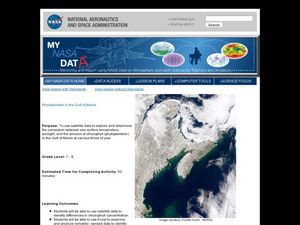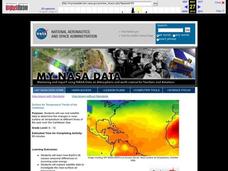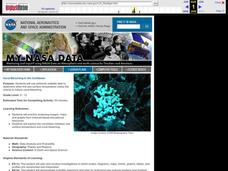Curated OER
Genres, Genres Everywhere
Young readers assume the role of Genre Sleuths to investigate the characteristics of folktales, fantasies, and mysteries. For this session you will need to collect a variety of books on a topic you have been studying. Groups then examine...
Curated OER
Hawaiian Bowl!
Students describe the movement of tectonic plates in the Hawaiian archipelago region. They describe how a combination of hotspot activity and tectonic plate movement could produce the arrangement of seamounts obse
Montana State University
What's the Weather?
How many jackets do you need to stay warm and climb Mount Everest? An informatie resource covers the topic of Mount Everest, the resource helps young scientists discover the difference between climate and weather. Activities include...
NOAA
El Niño
El Nino, La Nina ... and the Santa Maria? The 11th installment of a 23-part NOAA Enrichment in Marine sciences and Oceanography (NEMO) program explains the mechanism of El Nino/Southern Oscillation. Pupils use previous data to determine...
Curated OER
Hurricanes As Heat Engines
Students examine sea surface temperatures to see how hurricanes get heat from the oceans surface. In this hurricanes lesson students use the Internet to find data and make line plots.
Scholastic
Perfect Postcards: California
It's time to hear about some adventures in travel! The Transcontinental Railroad changed life and travel in the United States during the 1800s. Practicing online research skills, pupils discover the features they would like to visit on...
Curated OER
Phytoplankton in the Gulf of Maine
Students use satellite data to see the correlation between sea temperature and sunlight in the Gulf of Maine. In this phytoplankton lesson students use Excel to analyze data.
Polar Trec
Global Snow Cover Changes
Snow is actually translucent, reflecting light off its surface which creates its white appearance. Pairs or individuals access the given website and answer questions about snow cover. They analyze graphs and charts, examine data, and...
Teach Engineering
Are We Alone?
Find an answer to the age-old debate of whether life exists on Mars. Groups determine criteria to help look for signs of life on Mars. The activity has the class simulate testing Martian soil samples for signs of life before drawing...
Polar Trec
Rings of Life
Individuals analyze tree rings to determine the health of an ecosystem. They then look at otoliths of fish, hard calcium carbonate structures located behind the brain, in the same manner.
Curated OER
Go West With Lewis and Clark! Scavenger Hunt
In this Lewis and Clark scavenger hunt activity, students participate in an Internet scavenger hunt to answer five questions regarding the Lewis and Clark expedition.
Curated OER
El Nino Lesson
Students compare graphs of weather occurrences. In this environmental lesson plan, students will being using the website to gather weather related information for a certain time period. The students will then graph the data that will be...
Curated OER
Panama Canal
Students investigate a way to sail a boat around the world without touching land while learning about the Panama Canal. In this Panama Canal lesson plan, students learn about the relationship of socio-political continents and how the...
Curated OER
Measuring Precipitation
A little engineering design is mixed into this lesson on precipitation measurement. Groups plan and construct a rain gauge, and use it to collect precipitation. As part of the PowerPoint presentation, learners view a satellite map of...
Curated OER
Conditions at Sea Data Activity
Students study how to forecast sea conditions. In this oceanography lesson students complete a class activity on wave making.
Curated OER
What's A Water Column Profile?
Students investigate water column data. In this earth science and seawater lesson plan, students determine how temperature, salinity, and density have an impact on sea water by viewing and analyzing data obtained from a number of...
Curated OER
Barnegat Bay Watershed
Students design a model watershed. In this watershed instructional activity, students learn the needed parts of a watershed and how they work. Students evaluate how watersheds effect communities.
Curated OER
Conservation and Environmental Protection
Students brainstorm a list of environments and animals from around the world that need protection. They then design and create a slogan about an animal or environment and an environmental protection poster.
Curated OER
Octopus Lesson Plan
Learners read about the octopus and create an octopus out of ink and a deflated balloon. In this octopus lesson plan, students discuss the different defense mechanisms of the octopus and use the ink to demonstrate what happens if the...
Curated OER
Surface Air Temperature Trends of the Caribbean
Students investigate the seasonal changes to sea surface and near-surface air temperatures near the equator. They use actual satellite data to track and graph the differences in air and sea temperatures during different seasons in the...
Curated OER
Coral Bleaching in the Caribbean
Students use authentic satellite data on the NASA website to determine when the sea surface temperature meets the criteria to induce coral bleaching.
Curated OER
Uchiwa Lesson Plan
Learners view images from Japan's Summer Festival celebration. They create a uchiwa fan to use while doing the Kuma River Dance.
Curated OER
The Rhythm of Life - Episode 2 - Melody
Students complete a unit on melodies from various cultures. They watch an online program, analyze various melodies, write a short original melody, complete a worksheet, and compare/contrast three versions of "Amazing Grace."
Curated OER
A Real-Life Application of Ratio
Young scholars discuss the concept of "aspect ratio" of the Helios Prototype. They find real life objects that are taller or shorter than them by a certain amount. They practice with ratio and measurement.

























